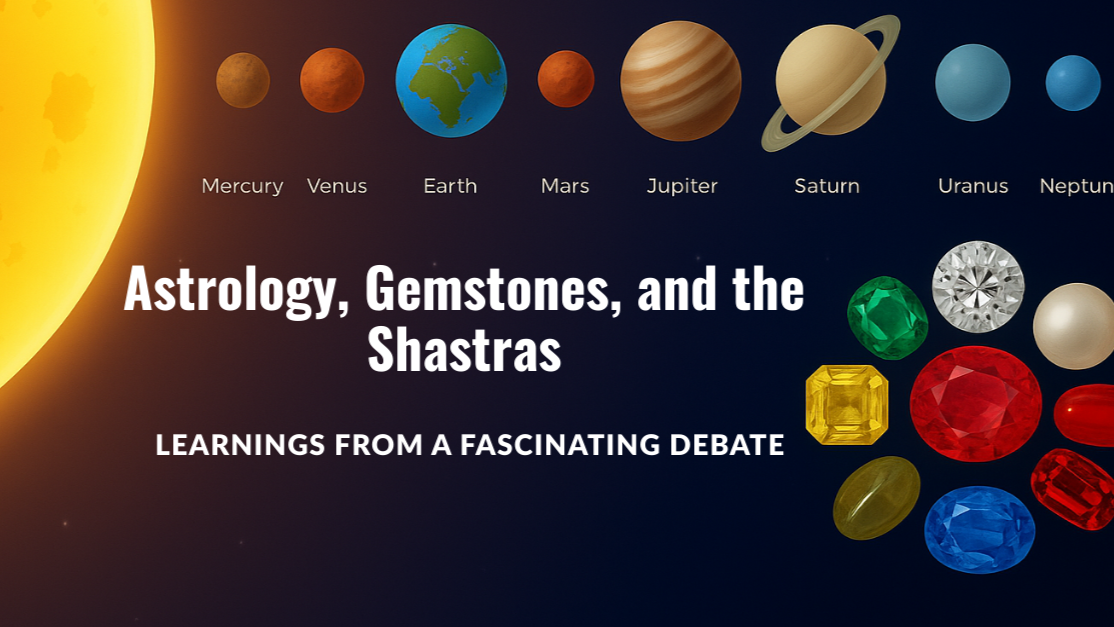As a gemologist, any topic on gemstones fascinates me. This particular discussion with a Vedic Shastri turned into one of the most thought-provoking conversations I’ve had — weaving together science, astrology, and even the business of belief.
The use of gemstones in astrology (ratna shastra) has always carried a sense of reverence and precision. Classical texts like the Garuda Purana, Brihat Samhita, Ratnapariksha, and Agni Purana all remind us: gemstones are not mere ornaments — they are carriers of planetary energies.
The right stone, worn correctly, is said to strengthen a benefic graha, reduce afflictions, and restore balance in life.
But in today’s world of advanced gemology, I found myself asking a simple question:
👉 Can lab-grown gemstones serve in astrology?
And his response led us down a fascinating rabbit hole.
📜 What the Shastras Actually Say
Authored by Varahamihira in the 6th century CE, the Brihat Samhita is a sweeping Sanskrit encyclopedia that captures the vast range of ancient Indian knowledge—from astrology to gemstones and beyond.
The guiding principle around Gemstones is surprisingly straightforward: A gemstone must be flawless and embody the true tatva (essence) of its mineral.
A Shloka From Ratna Parikhsha Section of Brihat Samitha
- Garuda Purana: “Mani ratna shuddho bhavati shubhadah” — A pure gemstone becomes the giver of auspicious results.
- Brihat Samhita: “Nirmalo ratna rajendra loka hite prabhavati” — A flawless gem benefits the world with its radiance.
- Ratnapariksha: “Dosha yukta na deyah…” — Gems with defects should not be prescribed.
- Agni Purana: “Ratnaanaam prabhavaad evam graha dosha nivaranam” — It is through gems that planetary afflictions are removed.
The Shastras emphasize purity, flawlessness, and tatva — not whether a gem was mined or grown in a lab.
💎 The Problem With Most “Astrological Gems”
A Highly Included Zambian Emerald
Here’s the irony:
While rubies and sapphires are actually rarer than diamonds — with fine pigeon-blood rubies or Kashmir sapphires fetching exceptional prices — most gems sold for astrology today are:
- Highly included and dull in color
- Heated, treated, or glass-filled
A far cry from the nirmal ratna envisioned in the texts.
Prescribed Characteristics of a Gem Stone
Meanwhile, the truly flawless, untreated, investment-grade gems the Shastras describe are so rare and expensive that they are typically purchased by collectors or HNIs — not for daily astrological wear.
🌐 Where Do Lab-Grown Gems Fit?
A Lab Grown Zambian Colored Emerald
This is where our debate got interesting.
If astrologers already prescribe CZ for diamond-like effect or spinel for ruby color — substitutes with entirely different lattices — then lab-grown gems stand on much firmer ground.
Because unlike CZ, a lab-grown ruby is still corundum:
- It has the same crystal lattice, same tatva, same planetary essence.
- It is flawless by default, aligning with the Shastric ideal of nirmal ratna.
- It is closer to the true stone than a glass-filled or resin-treated “natural” gem.
- The Shastra's clearly define the characteristics of the Gem Stones but do not prescribe where the Gem should originate from. In fact - they discuss various locations where the gemstones can be taken from.
Lab Grown Gems may not replace rare untreated natural gems in vibrational therapy. But for color therapy and symbolic planetary alignment, they are far more authentic than most substitutes.
As one could argue: a flawless lab-grown emerald is actually closer to Shastric ideals than a cracked, glue-filled natural emerald.
📊 The Business of Belief
This isn’t just a philosophical debate — it’s also a multi-billion-dollar reality.
- The global gemstone market is valued at USD 36 billion, and forecast to rise to USD 68 billion by 2035 (CAGR 6.6%). (Future Market Insights)
- The global colored gemstone market alone was USD 6.8 billion in 2023, projected to reach USD 12.4 billion by 2032. (Dataintelo)
- GemPundit’s estimated annual revenue is around USD 25 million. (Growjo)
- While figures for GemstoneUniverse and MyRatna are less public, astrology-driven demand clearly forms a significant share of their sales.
In India especially, an astrologer’s recommendation often drives purchases more powerfully than design, fashion, or even investment.
🌟 My Takeaway
The Shastras are clear: gemstones must be pure, flawless, and of correct tatva. Very few gems in the astrology market today truly meet that standard.
While nothing replaces a rare, untreated natural gem for vibrational resonance, lab-grown gems stand as a dignified and logical middle ground:
- More authentic than CZ or glass-filled substitutes
- Far more accessible than investment-grade rubies or sapphires
💡 In other words: if astrology is about alignment, then lab-grown gems may just be the most aligned choice for today’s seeker.
👉 Would you choose a gem for where it comes from, or for the qualities it carries within?
Explore More Here: Can Lab-Grown Gemstones Be Prescribed for Astrology?




